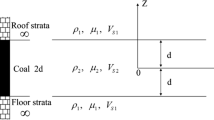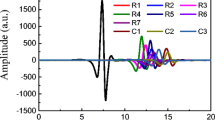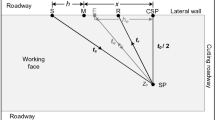Abstract
Most methods using transmitted channel wave (TCW) prospecting to quantitatively detect the thickness of coal seams based on the statistic relationship of group velocity in certain wave bands to the thickness of coal seams cannot be applied universally. To establish a universal applicable method, we first obtained the theoretical dispersion curve of TCW using the generalized reflection–transmission coefficient method and the 1-D horizontal multilayer velocity model, performed iteratively match calculation using the inversion model and the genetic algorithm and analyzed the distributive characteristics of shear wave velocity of coal and rock formations at a certain depth. We then obtained the 3-D velocity images of the coal seam working face based on TCW data using the 3-D back-projection technology. According to the changes of shear wave velocity at the coal–rock interface and the rate of inversion velocity change, we further proposed the quantitative discriminant model for coalbed thickness. Based on the model, we quantitatively interpreted the thickness of the coal seam by computing the depths corresponding to the extremes of the positive and negative rate of the shear wave velocity change and obtained the distribution characteristics of the coal thickness in the working surface. To verify the feasibility and validity of the proposed model for coalbed thickness, we conducted a 3-D physical similarity model experiment and subjected the collected two-component TCW data to inversion calculation and compared the obtained coal seam thickness with the known model parameters. Overall, our study achieved the universal 3-D quantitative detection of coalbed thickness and provided technical supports for intelligentized coalbed mining.











Similar content being viewed by others
References
Buyuk E, Zor E, Karaman A (2017) Rayleigh wave dispersion curve inversion by using particle swarm optimization and genetic algorithm [C]// In: EGU General Assembly Conference. EGU General Assembly Conference Abstracts
Buchen PW, Ben-Hador R (2007) Free-mode surface-wave computations. Geophys J Int 124(3):869–887
Calderónmacías C, Luke B (2007) Improved parameterization to invert Rayleigh-wave data for shallow profiles containing stiff inclusions. Geophysics 72(1):1–10
Chen T, Wang X (2016) Thickness prediction of tectonically deformed coal using calibrated seismic attributes: a case study. ASEG Ext Abstr 1:1–5
Chen X (1993) A systematic and efficient method of computing normal modes for multilayered half-space. Geophys J Int 115(2):391–409
Cox KB, Mason IM (1988) Velocity analysis of SH channel waves in the Schwalback seam of Ensdorf Colliery [J]. Geophys Prospect 36(3):298–317
Du W, Peng S (2010) Coal seam thickness prediction with geostatistics [J]. Chin J Rock Mechan Eng 29(s1):2762–2767
Feng S, Sugiyama T, Yamanaka H (2005) Effectiveness of multi-mode surface wave inversion in shallow engineering site investigations. Explor Geophys 58(1):26–33
Forbriger T (2003) Inversion of shallow-seismic wave fields: II. inferring subsurface properties from wavefield transforms. Geophys J Royal Astron Soc 153(3):719–734
Haskell NA (1953) The dispersion of surface waves on multilayered media. Bull Seismol Soc Am 43:17–34
Hu Z, Zhang P, Xu G (2018) Dispersion features of transmitted channel waves and inversion of coal seam thickness. Acta Geophys 66(5):1001–1009
Hu Z, Zhang P, Xu G (2017) Research advances of seismic tomography technology in coal seam. Prog Geophys 32:2451–2459
Ji G, Li H, Wei J et al (2019) Preliminary study on wave field and dispersion characteristics of channel waves in VTI coal seam media. Acta Geophys 4:1–12
Knopoff L (1964) A matrix method for elastic wave problems. Bull Seismol Soc Am 54(1):431–438
Krajewski P, Dresen L, Schott W et al (1987) Studies of roadway modes in a coal seam by dispersion and polarization analysis: a case history. Geophys Prospect 35:767–786
Lei F, Wang W, Li S, Yao X, Teng J, Gao X (2017) Research on the channel wave field characters of goaf in coal mine and its application. In: Di Q, Xue G, Xia J (eds) Technology and Application of Environmental and Engineering Geophysics. Springer Geophysics. Springer, Singapore
Li Q, Guo L, Sun Y et al (2017) Seismic attributes fusion and its research in predicting thickness of coal [J]. Prog Geophys 32(5):2014–2020
Peng S, Gao Y, Peng X et al (2004) Study on the rock physic parameters of coal bearing strata in Huainan Coalfield. J China Coal Soc 29(2):177–181
Peng S, Feng J et al (2019) Automation in U.S. longwall coal mining: A state-of-the-art review. Int J Mining Sci Technol 2:151–159
Schott W, Waclawik P (2015) On the quantitative determination of coal seam thickness by means of in-seam seismic surveys. Can Geotech J 52:1496–1504
Schwab I (1970) Surface-wave dispersion computations: Knopoff’s method. Bull Seismol Soc Am 60(2):321–344
Stockwell RG (2007) A basis for efficient representation of the S-transform. Digital Signal Process 17(1):371–393
Thomson WT (1950) Transmission of elastic waves through a stratified solid medium. J Appl Phys 21(2):89–93
Wang W, Gao X, Li S (2012) Channel wave tomography method and its application in coal mine exploration: An example from Henan Yima Mining area. Chinese J Geophys 55(3):1054–1062
Wang W, Xue G, Gao X, et al (2016) Channel wave tomographic imaging method and its application in detection of collapse column in coal// In: International Conference on Environment and Engineering Geophysics & Summit Forum of Chinese Academy of Engineering on Engineering Science and Technology.
Wang B, Liu S, Zhou F et al (2016) Dispersion characteristics of SH transmitted channel waves and comparative study of dispersion analysis methods. J Comput Theor Nanosci 13(2):1468–1474
Wang C, Si J, Zhang X (2016) Research on similar material proportioning test based on orthogonal design. Coal Technol 35(8):21–23
Wang X, Li Y, Chen T et al (2017) Quantitative thickness prediction of tectonically deformed coal using extreme learning machine and principal component analysis: a case study [J]. Comput Geosci 101:38–47
Xiao Y, Wu R, Yan J et al (2017) Field strength propagation law of radio wave penetration and effective perspective width for coal face. J China Coal Soc 42(3):712–718
Xia J, Gao L, Pan Y et al (2015) New findings in high-frequency surface wave method [J]. Chinese J Geophys (in Chinese) 58(8):2591–2605
Yamanaka H, Ishida H (1996) Application of genetic algorithm to an inversion of surface-wave dispersion data. Bull Seismol Soc Am 86(2):436–444
Yuan L (2017) Scientific conception of precision coal mining. J China Coal Soc 42(1):1–7
Zhu M, Cheng J, Cui W et al (2019) Comprehensive prediction of coal seam thickness by using in-seam seismic surveys and Bayesian kriging. Acta Geophys 67(3):825–836
Zou G, Xu Z, Peng S et al (2018) Analysis of coal seam thickness and seismic wave amplitude: A wedge model. J Appl Geophys 148:245–255
Acknowledgements
This work was supported by the Natural Science Study of the Department of Education, Anhui Province (No. KJ2019A0125), Anhui Provincial Natural Science Foundation (No. 2008085QD185) and the National Natural Science Foundation (No. 41877268). Special thanks are given to the anonymous reviewers for their assistance, comments and suggestions.
Author information
Authors and Affiliations
Corresponding author
Rights and permissions
About this article
Cite this article
Hu, Z., Zhang, P., Ji, G. et al. Study on transmitted channel wave-based, horizontal multilayer 3-D velocity model inversion and quantitative coalbed thickness detection method. Acta Geophys. 68, 1703–1713 (2020). https://doi.org/10.1007/s11600-020-00500-6
Received:
Accepted:
Published:
Issue Date:
DOI: https://doi.org/10.1007/s11600-020-00500-6




